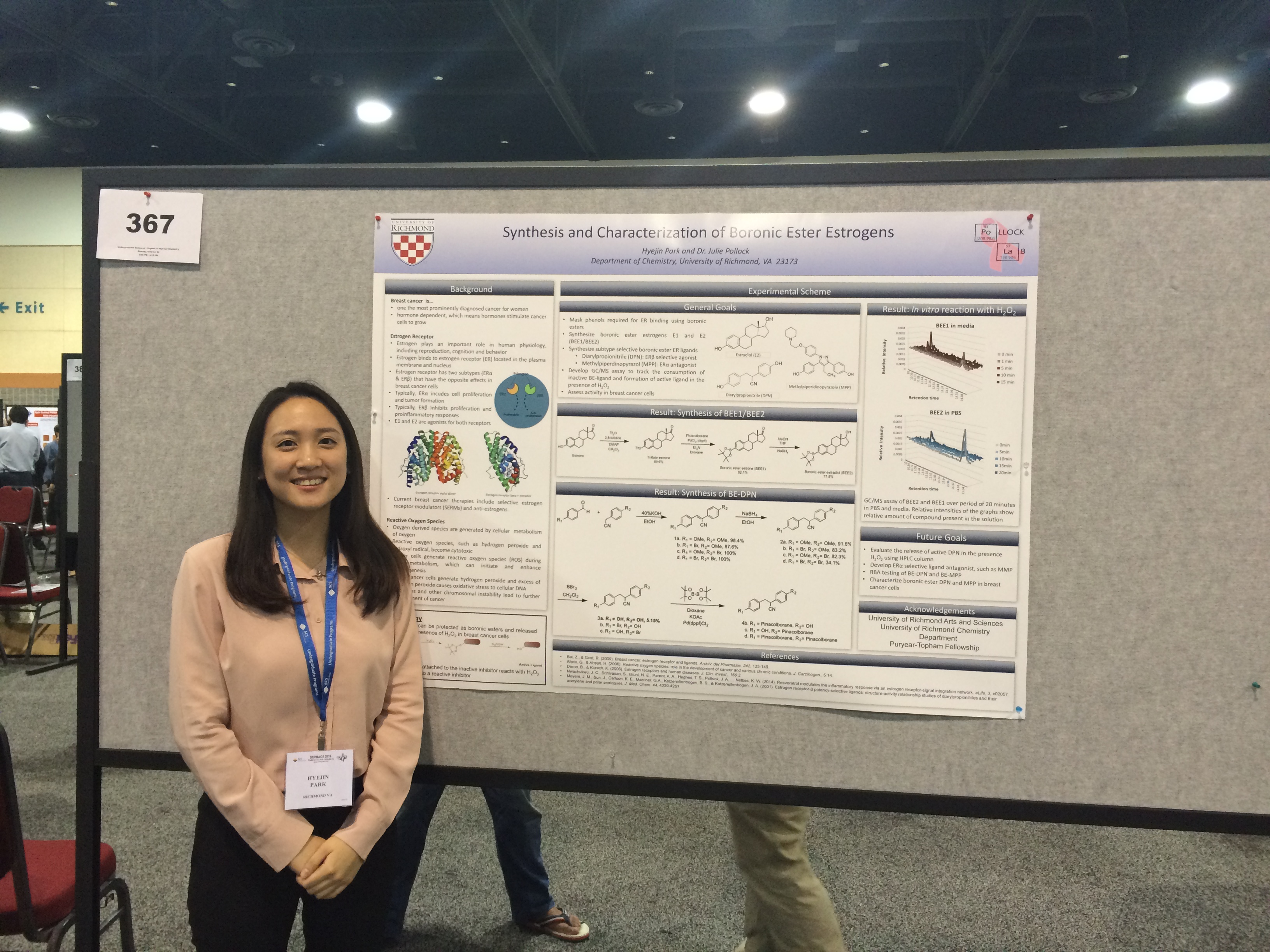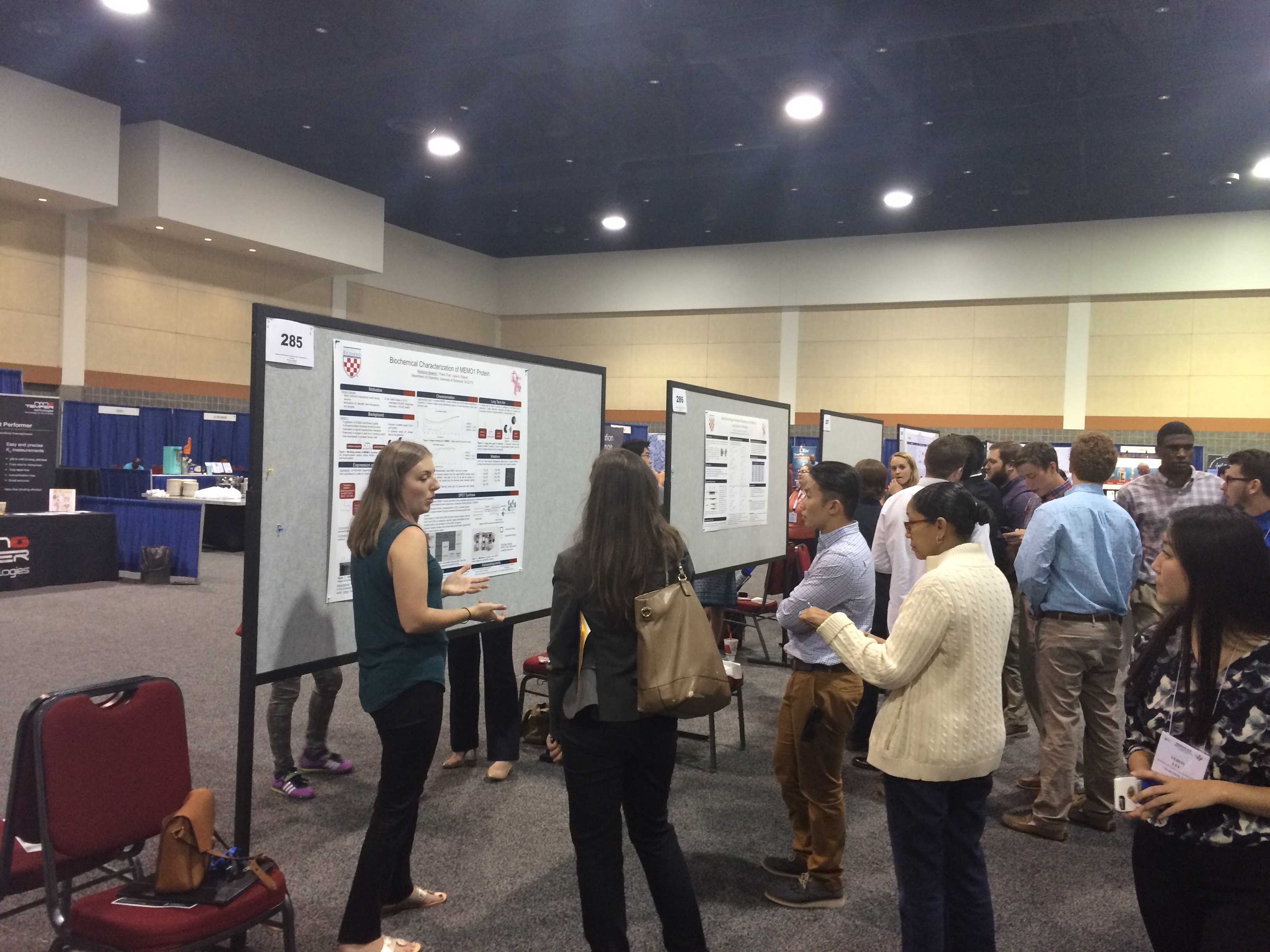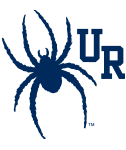
Two weeks ago the Pollock lab traveled to Columbia, SC to attend and present at the Southeastern Regional Conference of the American Chemical Society.
If I’m being honest, I was excited and worried about our first set of presentations off-campus. The lab work is going well but we are not quite ready for publications yet. I had lots of questions and fears in my mind leading up to our trip. What would people think about our work? Would people try to scoop our plans? Would people be antagonistic against the undergraduates? Would someone else be presenting the same studies? These hesitations were mirrored with benefits I knew would come to my lab students. It would be their first experience at a chemistry conference. They would get to hear talks from graduate students and professors. They would present to people they had never met before. They would attend a graduate school fair. They would be immersed in the world of research.
Reflecting back on our trip, I know it was a good decision. The experience for the students and the pride I felt watching them present their research far outweighed the anxiety. Maddie, Hyejin, and James- you did a great job!
Before we left for the trip, I tasked them with choosing their favorite presentation (oral or poster) and writing up a reflective piece on why it spoke to them directly. See those summaries and a few photos of our trip below.
-JAP
Hyejin Park '17
“Matthew Lockett, from University of North Carolina at Chapel Hill, talked about the use of 3D paper-based cultures to imitate tumor-like environments in the tissue. His study focuses on the chemoattractant properties of oxygen, because oxygen is the master regulator for tissues and cancer cells. Current in vitro studies done in laboratories rely on 2D cell culture plates, which do not represent in vivo environments. Constructing a 3D cell culture that can be easily manipulated and controlled will give a better understanding of cellular responses to oxygen gradients and drug metabolism in microenvironment. Dr. Lockett’s research uses paper-based scaffolds – individual paper layers stacked to support cells in hydrogels. So far, he has discovered that tumor cell growth and hypoxia-related gene upreguation are dependent on the oxygen gradient. He is currently studying how the oxygen gradient influences drug penetration and metabolism. I found this research very interesting because paper is a readily available material that does not require extensive care and cost. Research done in vitro is not likely to be representative of real-life environments, as cells are in a complex system. I think this research could be used to aid novel drug discovery that is applicable and effective.”




James Henry '17
“The first talk I attended on my second day attending SERMACS, was at 8 A.M. and hosted by Dr. Harry Gray, of the Beckman Institute at Cal. Tech. Professor Gray was the Powell Lecture Series Speaker in 2012 at the University of Richmond. His talk detailed 56+ years of research experience in approximately 45 minutes as the keynote speaker for Monday’s events. Professor Gray detailed his interdisciplinary research program that focuses on a wide range of fundamental problems in inorganic chemistry/biochemistry/biophysics. Much of this research is focused on electron-transfer chemistry. Dr. Gray focused his discussion on oxo-metal ions and his proverbial “oxo-wall” with a detailed explanation of his progress in understanding how covalent bridges mediate long-range electron transfer reactions. Currently, Dr. Gray is looking at intermediate protein radicals/solvent systems and how they accelerate long-range electron transfer.
Dr. Grey is using his approaches to study of several other redox enzymes (e.g., nitric oxide synthase, catechol oxidase, amine oxidase). The most interesting aspect of Dr. Gray’s research is his use of laser-induced electron-transfer reactions to probe the folding of redox proteins. Dr. Gray has partnered with thousands of students, faculty and institutions to solve one of earth’s most important problems. One idea includes using lasers and oxo-metal catalysts to change salt water, carbon dioxide, methane, (harmful compounds) into food, fuel and materials (oxygen included).
The science behind this talk is not only fascinating but also imperative as we move forward. Carbon dioxide levels on our planet are increasing and as a result the earth’s temperature is warming. Innovative methods are needed to undo this rapid amplification of climate change. This creative idea, turning harmful waste into beneficial products, serves multiple purposes and has tremendous future implications in the effort to reverse human inducted climate change.”
Maddie Newkirk '18
Presenter: Clarissa Weaver
University: Grad Student, University of Alabama, Birmingham
Title: Saccharomyces cerevisiae Hsp104 is a non-processive polypeptide translocase
“This was my favorite talk because it was easy to understand and Ms. Weaver was enthusiastic and engaging. She began her talk with a 3 minute thesis where she went over the outline of her talk and the basics of her research. Because she took the time to do this, it was easier to understand the rest of her talk. In the 3 minute thesis, she used tangled Christmas tree lights as an analogy for her research. She researches a protein called Hsp104 that may be capable of untangling tangled neurons in neurodegenerative diseases such as Alzhiemers reversing the damage to the brain. Ms. Weaver studied the conformation of the protein and also looked for hot spots on the protein. She utilized a stop-flow fluorescence assay to examine her protein and examine for the hot spots. This was super interesting to me, as I am about to begin creating a fluorescence polarization assay of my own. It was cool to hear about and also reassuring to hear that someone else did it and it worked. Overall, her talk was my favorite because of its easiness to understand and because I found the content the most interesting as it correlated to my research.”



Recent Comments